High LDL cholesterol poses serious health risks that many people don’t realize until it’s too late. When LDL cholesterol levels remain elevated, it builds up in artery walls and forms dangerous plaque that can lead to heart attacks, strokes, and other life-threatening conditions. The most concerning aspect is that high LDL often has no symptoms until it becomes serious[1], making regular testing essential.
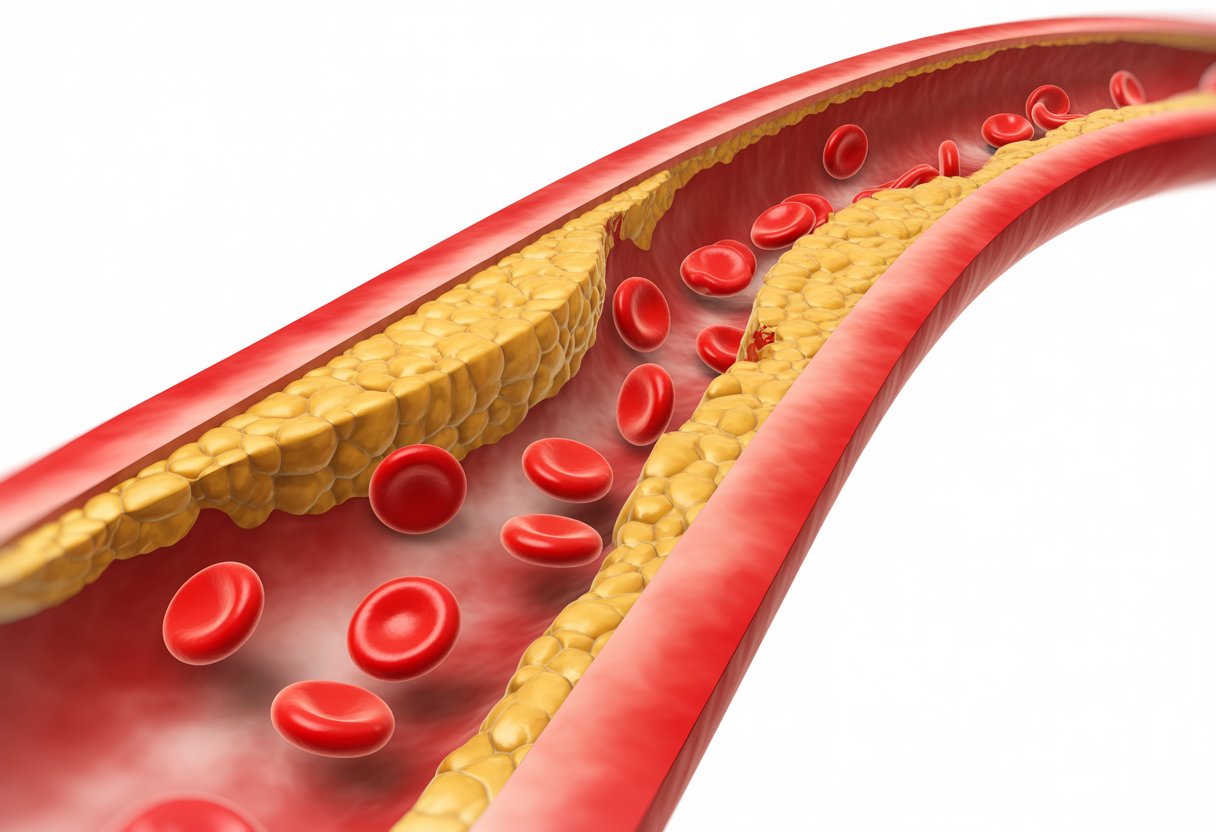
Unlike other health problems that give clear warning signs, elevated LDL cholesterol silently damages blood vessels throughout the body. This “bad” cholesterol doesn’t just affect the heart – it can cause chest pain, narrow arteries, and increase blood pressure[1] while reducing blood flow to vital organs.
The good news is that high LDL cholesterol responds well to treatment when caught early. Through lifestyle changes and medical interventions, people can significantly lower their levels and reduce their risk of serious complications. Understanding what happens when LDL cholesterol rises too high empowers individuals to take control of their cardiovascular health before permanent damage occurs.
Key Takeaways
- High LDL cholesterol creates plaque buildup in arteries that can cause heart attacks and strokes
- Elevated LDL levels typically show no symptoms until serious complications develop
- Treatment through diet, exercise, and medication can effectively lower LDL cholesterol and reduce health risks
Immediate Health Risks of High LDL Cholesterol
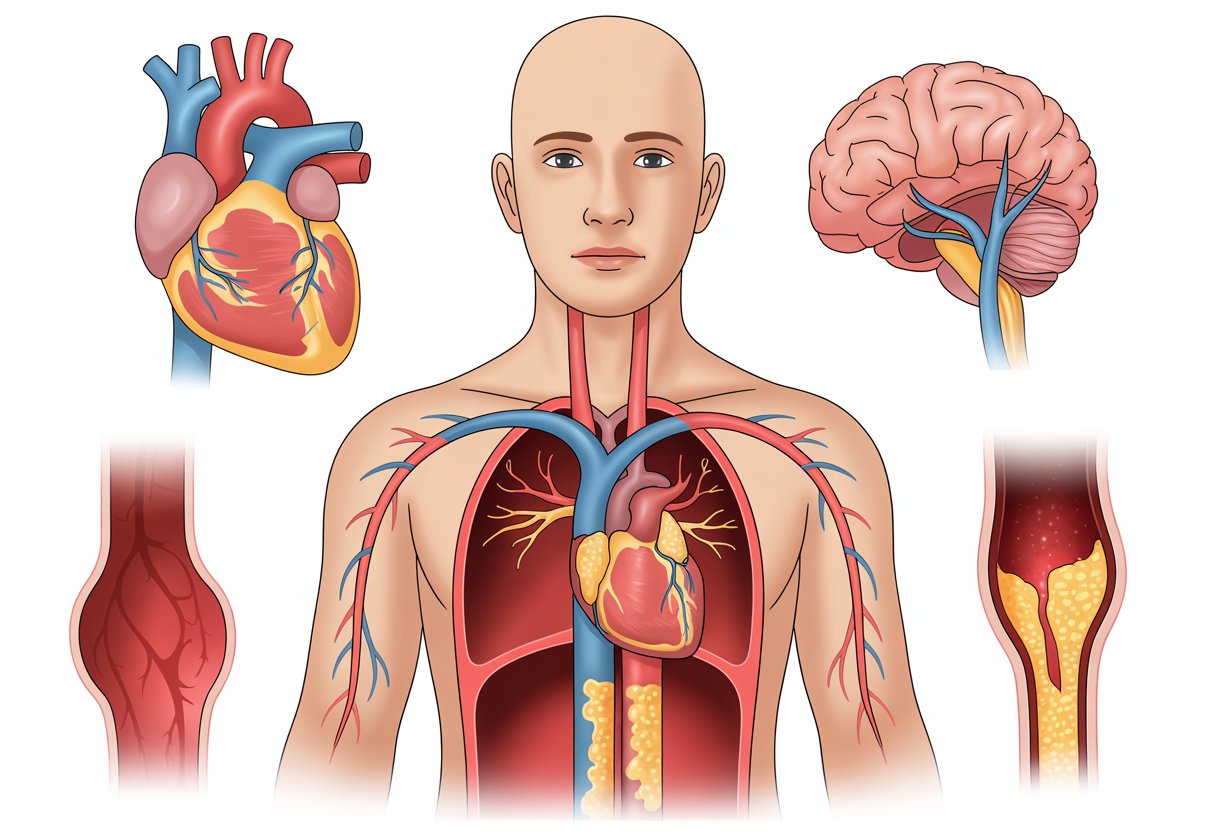
High LDL cholesterol creates dangerous plaque buildup in arteries that can quickly lead to life-threatening events. The excess cholesterol blocks blood flow to vital organs, triggering heart attacks, strokes, and circulation problems in the limbs.
Increased Risk of Heart Attack
High LDL cholesterol raises heart attack risk[1] by forming sticky plaque deposits inside coronary arteries. These deposits contain LDL cholesterol, fats, and cell debris that narrow the pathways carrying blood to the heart.
When plaque ruptures suddenly, it triggers blood clot formation. The clot can completely block the artery, cutting off oxygen supply to heart muscle tissue. This causes a myocardial infarction or heart attack.
Warning signs include:
- Chest pressure or tightness
- Pain spreading to arms, neck, or jaw
- Shortness of breath
- Nausea or sweating
The heart muscle begins dying within minutes without oxygen. Quick medical treatment can restore blood flow and save heart tissue from permanent damage.
Stroke and Blood Clots
High LDL increases ischemic stroke risk[1] when plaque builds up in brain arteries. The narrowed vessels reduce blood flow to brain tissue, potentially causing a transient ischemic attack or mini-stroke.
A full stroke occurs when plaque ruptures and forms a clot that completely blocks brain blood supply. Brain cells start dying rapidly without oxygen and nutrients.
Stroke symptoms appear suddenly:
- Face drooping on one side
- Arm weakness or numbness
- Speech problems or confusion
- Severe headache
Ischemic strokes account for about 85% of all strokes. The blocked artery prevents oxygen from reaching brain regions, causing permanent damage if not treated immediately. Even small clots can destroy critical brain functions.
Peripheral Artery Disease
High LDL can block blood flow to legs and arms[1], causing peripheral artery disease. The same plaque formation process that affects heart and brain arteries also damages vessels in the extremities.
Reduced blood flow creates painful symptoms during physical activity. The muscles cannot get enough oxygen during exercise or walking.
Common PAD symptoms:
- Leg pain while walking that improves with rest
- Numbness or weakness in limbs
- Cold feet or hands
- Slow-healing wounds
- Color changes in skin
PAD significantly increases infection risk because poor circulation prevents proper wound healing. Minor cuts or injuries can become serious medical problems without adequate blood flow to deliver immune cells and nutrients.
Long-Term Effects of Elevated LDL Levels
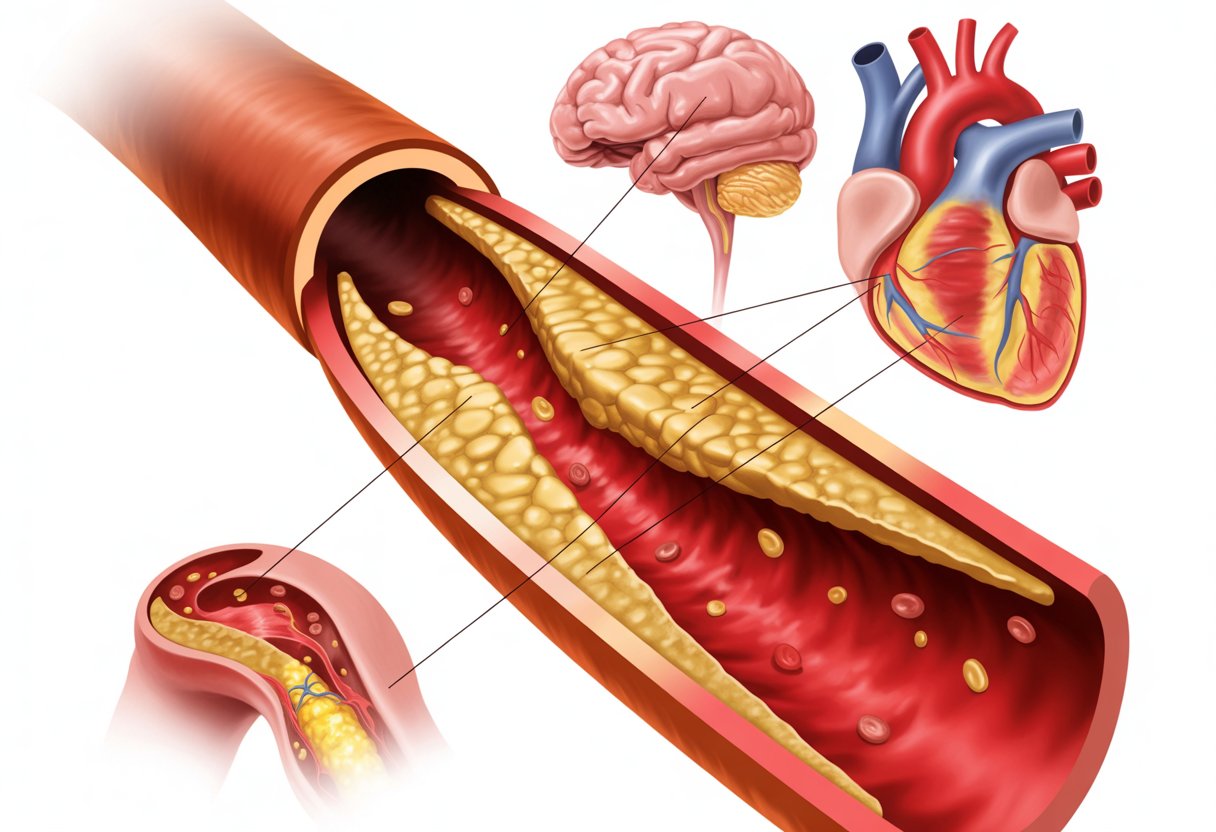
High LDL cholesterol creates lasting damage that builds up over years, leading to blocked arteries, reduced blood flow to vital organs, and changes in how the body processes fats and sugars.
Atherosclerosis Progression
LDL cholesterol sticks to artery walls and forms sticky deposits called plaque. This buildup happens slowly over many years without symptoms.
The plaque makes arteries stiff and narrow. Blood cannot flow as easily through these damaged vessels.
High LDL can narrow arteries[1] and cause atherosclerosis. The condition gets worse as more plaque builds up.
Key stages of atherosclerosis:
- Early stage: Small amounts of LDL enter artery walls
- Middle stage: Plaque forms and grows larger
- Advanced stage: Arteries become very narrow or blocked
The heart must work harder to pump blood through narrowed arteries. This extra work puts stress on the cardiovascular system.
Plaque can rupture suddenly and form blood clots. These clots can completely block blood flow to important organs.
Organ Damage Over Time
The brain suffers when plaque blocks arteries that supply blood to brain tissue. High LDL increases the risk for ischemic stroke[1] when blood clots cut off oxygen to the brain.
The heart muscle needs constant blood flow to work properly. Blocked coronary arteries can cause chest pain called angina.
Organs most affected by high LDL:
- Heart (coronary artery disease)
- Brain (stroke risk)
- Kidneys (reduced blood flow)
- Legs and arms (peripheral artery disease)
High LDL increases the risk of peripheral artery disease[1], which affects blood flow to the legs and arms. This causes pain, numbness, and slow-healing wounds.
The kidneys filter waste from blood and need good circulation to work well. Poor blood flow can damage kidney function over time.
Metabolic Complications
High LDL often occurs with other metabolic problems. People with elevated cholesterol frequently develop type 2 diabetes.
The combination of high cholesterol and diabetes creates much higher risks for heart disease. Both conditions damage blood vessels in different ways.
Common metabolic changes:
- Insulin resistance
- High blood pressure
- Increased inflammation
- Weight gain around the waist
High LDL makes high blood pressure worse[1] because the heart works harder to push blood through clogged arteries. This creates a cycle where both conditions get worse.
Inflammation increases throughout the body when LDL levels stay high. This inflammation speeds up the formation of new plaque in arteries.
The liver produces more cholesterol when it cannot clear LDL from the blood effectively. This makes the problem worse over time.
Underlying Causes of High LDL Cholesterol
Several factors work together to raise LDL cholesterol levels in the blood. Poor eating habits, lack of exercise, family genes, and certain health problems all play important roles in increasing bad cholesterol.
Diet and Lifestyle Factors
Food choices have a major impact on LDL cholesterol levels. Foods high in saturated fats raise bad cholesterol[2] and include fatty cuts of beef and pork, chicken skin, and full-fat dairy products like butter and cheese.
Foods that raise LDL cholesterol:
- Fatty meats (ribs, bacon, sausage)
- Full-fat dairy products
- Fried foods
- Ultra-processed foods with trans fats
Sugar also causes problems by lowering good HDL cholesterol while raising triglycerides. Ultra-processed foods often contain added sugars, salt, and chemical additives that harm cholesterol levels.
Lack of exercise makes cholesterol problems worse. Regular physical activity helps the body manage cholesterol better and keeps weight in a healthy range.
Being overweight puts extra stress on the body’s cholesterol system. Extra weight makes it harder for the body to process fats properly.
Smoking damages blood vessels and makes it easier for cholesterol to stick to artery walls. This creates more plaque buildup over time.
Genetic Predisposition
Some people inherit genes that make their bodies produce too much cholesterol. High cholesterol can run in families[2], making it harder to keep levels normal even with good habits.
People are born with LDL levels between 40-60 mg/dL. As they get older, these numbers naturally go up.
Family history of heart disease or high cholesterol increases the risk. If parents or siblings have cholesterol problems, other family members are more likely to have them too.
Some genetic conditions cause very high cholesterol from birth. These rare conditions need special medical treatment because lifestyle changes alone are not enough.
Genetic testing can help doctors understand if high cholesterol comes from family genes. This information helps them choose the best treatment plan.
Medical Conditions That Influence LDL
Several health problems can make LDL cholesterol levels go up. Diabetes affects how the body processes fats and often leads to higher bad cholesterol.
Medical conditions that raise LDL:
- Type 2 diabetes
- Kidney disease
- Liver disease
- Thyroid problems (underactive thyroid)
- Polycystic ovary syndrome (PCOS)
Kidney disease changes how the body removes waste and fats from the blood. This can cause cholesterol to build up to dangerous levels.
An underactive thyroid slows down the body’s metabolism. This makes it harder to break down and remove cholesterol from the blood.
Some medications can also raise cholesterol levels. Birth control pills, steroids, and certain blood pressure medicines may increase LDL in some people.
Age naturally increases cholesterol production. The liver makes more cholesterol as people get older[2], which explains why cholesterol problems become more common with age.
How High LDL Cholesterol Is Diagnosed
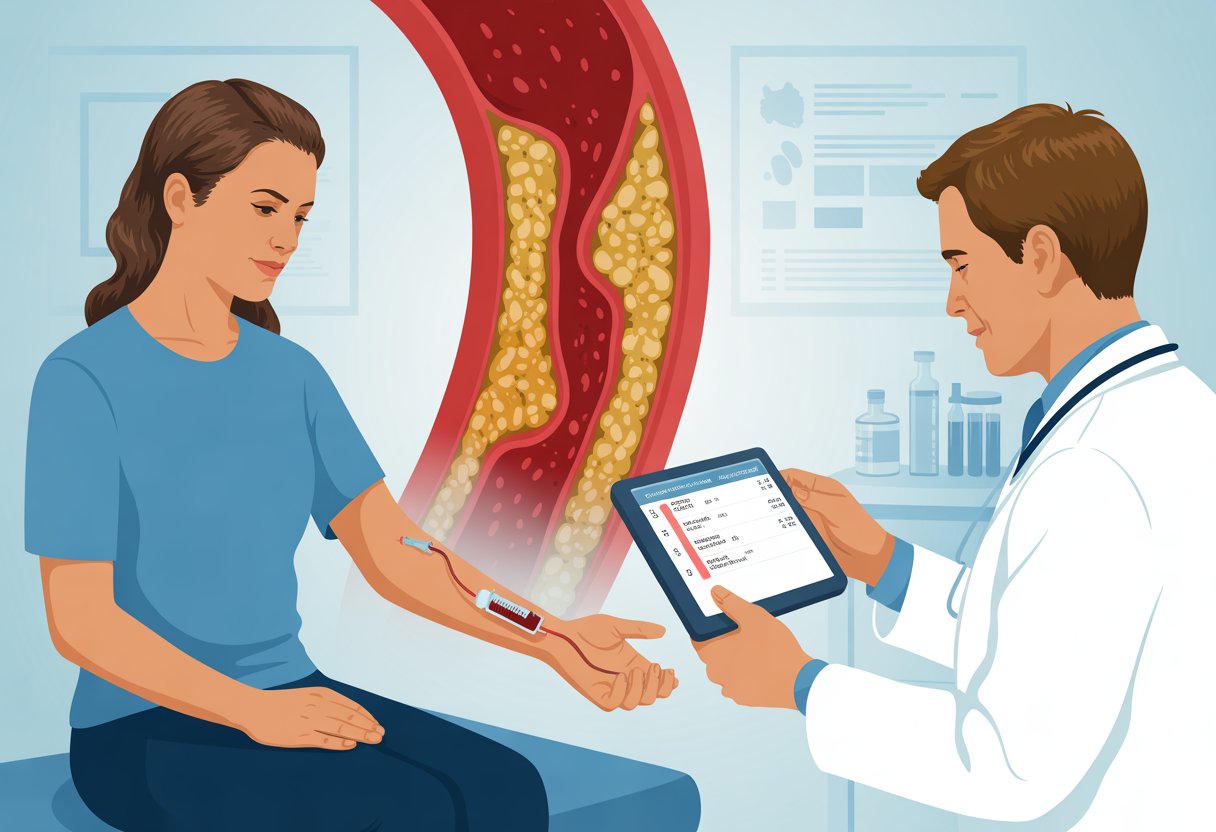
Doctors use simple blood tests to check LDL cholesterol levels, and high cholesterol typically doesn’t cause symptoms[3] until serious problems develop. Understanding the numbers helps patients know their risk for heart disease and stroke.
Cholesterol Blood Tests
A lipid panel measures cholesterol levels through a blood sample taken from the arm. This test shows total cholesterol, LDL, HDL, and triglycerides.
Patients typically fast for 9-12 hours before the test. This means no food or drinks except water during that time.
The blood draw takes just a few minutes. A healthcare worker uses a small needle to collect blood in a tube.
Test frequency varies by age and risk factors:
- Adults 20 and older: Every 4-6 years
- People with diabetes or heart disease: More often
- Those with family history: May need earlier or more frequent testing
Some newer tests don’t require fasting. Doctors can discuss which type works best for each patient.
Understanding LDL Numbers
LDL cholesterol gets measured in milligrams per deciliter (mg/dL). Different target levels apply based on a person’s risk factors[3].
Target LDL levels:
| Risk Level | Target LDL Level |
|---|---|
| Average risk adults | Less than 100 mg/dL |
| High risk for heart disease | Less than 70 mg/dL |
| People with heart disease | Less than 55 mg/dL |
Doctors look at other factors too. Age, smoking, diabetes, blood pressure, and family history all affect heart disease risk.
HDL cholesterol should ideally be above 60 mg/dL[4]. This “good” cholesterol helps remove bad cholesterol from arteries.
Additional Diagnostic Tools
Doctors may order extra tests if LDL levels are very high or if patients have other risk factors. These tests help create a complete picture of heart health.
A coronary calcium scan uses CT imaging to check for plaque buildup in heart arteries. This test helps doctors see if high cholesterol has already caused artery damage.
Other helpful tests include:
- C-reactive protein (checks for inflammation)
- Lipoprotein(a) levels
- Apolipoprotein B testing
Some patients need genetic testing. This helps identify inherited forms of high cholesterol that run in families.
An electrocardiogram (EKG) checks heart rhythm. Stress tests measure how the heart works during exercise.
These extra tests help doctors decide on the best treatment plan. They also help determine how aggressively to treat high LDL cholesterol.
Managing and Lowering High LDL Cholesterol
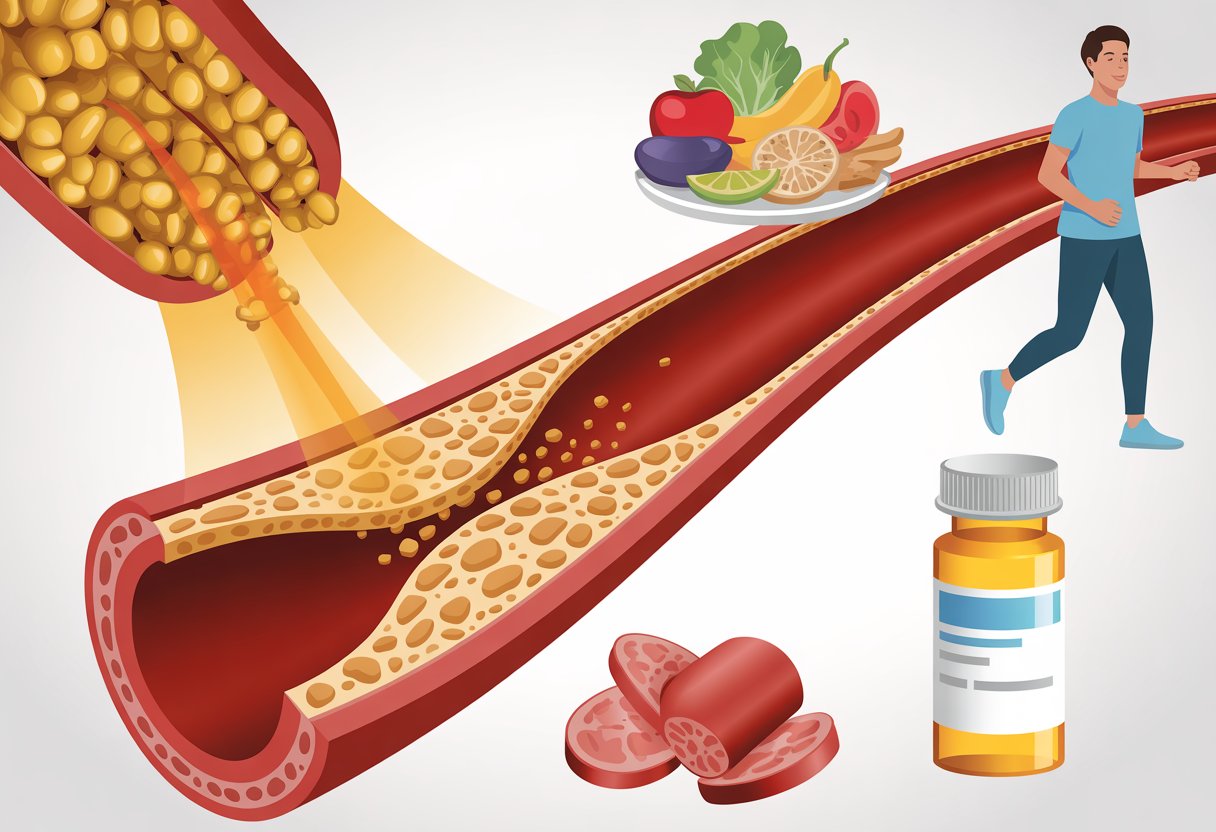
The good news is that high LDL cholesterol can be managed and reduced through proven methods. Most people can lower their levels by eating specific foods, exercising regularly, taking prescribed medications when needed, and getting regular blood tests to track progress.
Dietary Changes for Lowering LDL
Food choices play a major role in controlling LDL cholesterol levels. People should focus on eating foods that actively lower cholesterol rather than just avoiding unhealthy options.
Foods That Lower LDL:
- Oatmeal and whole grains
- Beans and legumes
- Apples, pears, and citrus fruits
- Nuts like almonds and walnuts
- Fatty fish such as salmon and mackerel
Soluble fiber blocks cholesterol absorption[5] in the digestive system. This type of fiber is found in oats, beans, and many fruits and vegetables.
Foods to Limit or Avoid:
- Fatty meats like sausage and bacon
- Full-fat dairy products
- Fried foods and fast food
- Baked goods with trans fats
Saturated and trans fats raise LDL cholesterol[5] more than any other part of the diet. People should replace butter with olive oil and choose lean meats over fatty cuts.
Exercise and Physical Activity
Regular exercise helps lower LDL cholesterol while raising HDL (good) cholesterol. Physical activity also helps people maintain a healthy weight, which supports better cholesterol levels.
Aerobic exercise for 30 minutes daily[5] provides the most benefit for cholesterol management. This includes walking, jogging, swimming, cycling, and dancing.
Effective Exercise Types:
- Brisk walking for 150 minutes per week
- Swimming or water aerobics
- Cycling or stationary bike
- Dancing or group fitness classes
People who are overweight may see bigger improvements in their cholesterol levels when they combine exercise with weight loss. Even modest weight loss of 5-10 pounds can make a difference.
Strength training twice a week also helps by building muscle and boosting metabolism. People should start slowly and gradually increase their activity level.
Medications and Medical Treatments
When lifestyle changes alone don’t lower LDL cholesterol enough, doctors may prescribe medications. Statins are the most common first choice for treating high cholesterol.
Common Cholesterol Medications:
- Statins – Block cholesterol production in the liver
- Ezetimibe – Reduces cholesterol absorption from food
- PCSK9 inhibitors – Help the liver remove more LDL from blood
- Bile acid sequestrants – Bind to cholesterol in the intestines
Most healthcare providers prescribe statins[5] as the first medication for high LDL cholesterol. These drugs are proven to reduce heart attack and stroke risk.
Some people may need combination therapy using two or more medications. Doctors consider factors like age, overall health, and other risk factors when choosing treatments.
People should never stop taking cholesterol medications without talking to their doctor first. Some may experience side effects, but most can find a medication that works well for them.
Monitoring Cholesterol Levels
Regular blood tests help track progress and determine if treatments are working. Most people need cholesterol checks every 4-6 months when starting new treatments.
A lipid panel measures total cholesterol, LDL, HDL, and triglycerides. People typically fast for 9-12 hours before this blood test for accurate results.
Target LDL Levels:
- Normal: Below 100 mg/dL
- High-risk patients: Below 70 mg/dL
- Very high-risk: Below 55 mg/dL
Doctors may recommend more frequent testing for people with very high cholesterol or those taking new medications. Home cholesterol test kits are available, but they’re not as accurate as lab tests.
People should keep a record of their cholesterol numbers over time. This helps them see trends and understand how well their treatment plan is working.
Consequences of Untreated High LDL Cholesterol
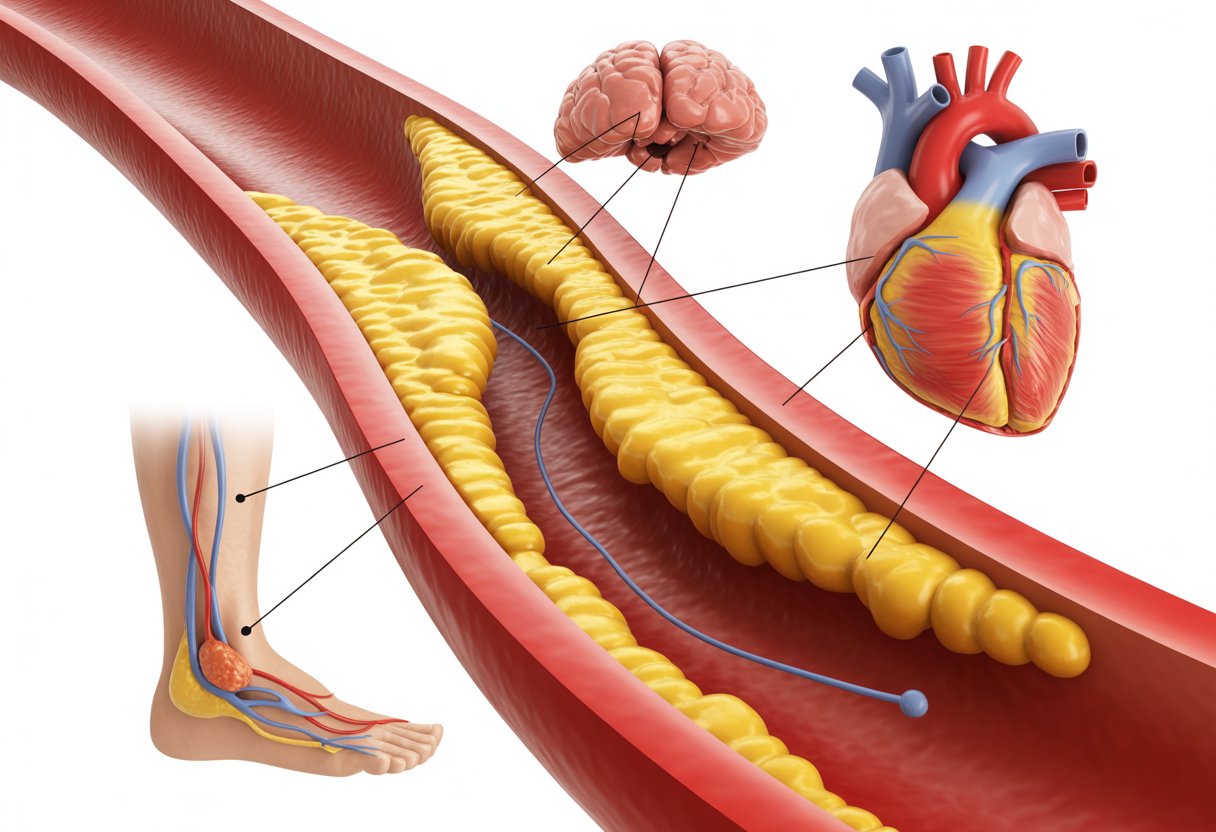
When LDL cholesterol remains high without treatment, it leads to plaque buildup in arteries throughout the body. This process restricts blood flow to vital organs and creates daily limitations that worsen over time.
Impact on Quality of Life
High LDL cholesterol significantly reduces a person’s ability to perform everyday activities. Peripheral artery disease develops when plaque clogs arteries[6] that supply blood to the arms and legs.
The most common symptom is claudication. This causes cramping or aching pain in the calf, thigh, or buttock muscles during walking or exercise.
People with this condition must stop frequently to rest when walking. Simple tasks like climbing stairs or walking to the mailbox become difficult.
The pain goes away with rest but returns with activity. Over time, the walking distance becomes shorter before pain starts.
Other symptoms that affect daily life include:
- Numbness or weakness in the legs
- Cold feet or hands
- Slow-healing cuts on the feet
- Hair loss on the affected limb
Complications for Other Conditions
Untreated high LDL cholesterol makes existing health problems worse and creates new ones. High cholesterol contributes to hypertension through accelerated atherosclerosis[6].
Kidney Problems: Plaque can block arteries that supply the kidneys. This leads to renal artery stenosis, which causes high blood pressure that is hard to control.
The kidneys may stop working properly. Blood creatinine levels rise, which can progress to chronic kidney disease.
Digestive Issues: When plaque blocks arteries to the intestines, it causes chronic mesenteric ischemia. People experience severe stomach pain 15 to 30 minutes after eating.
This leads to fear of eating and significant weight loss. The pain becomes so bad that people avoid meals entirely.
Heart and Brain Complications: High blood pressure from damaged blood vessels puts people at higher risk[7] for heart attack and stroke. These conditions often happen without warning in people with multiple health problems.
Frequently Asked Questions
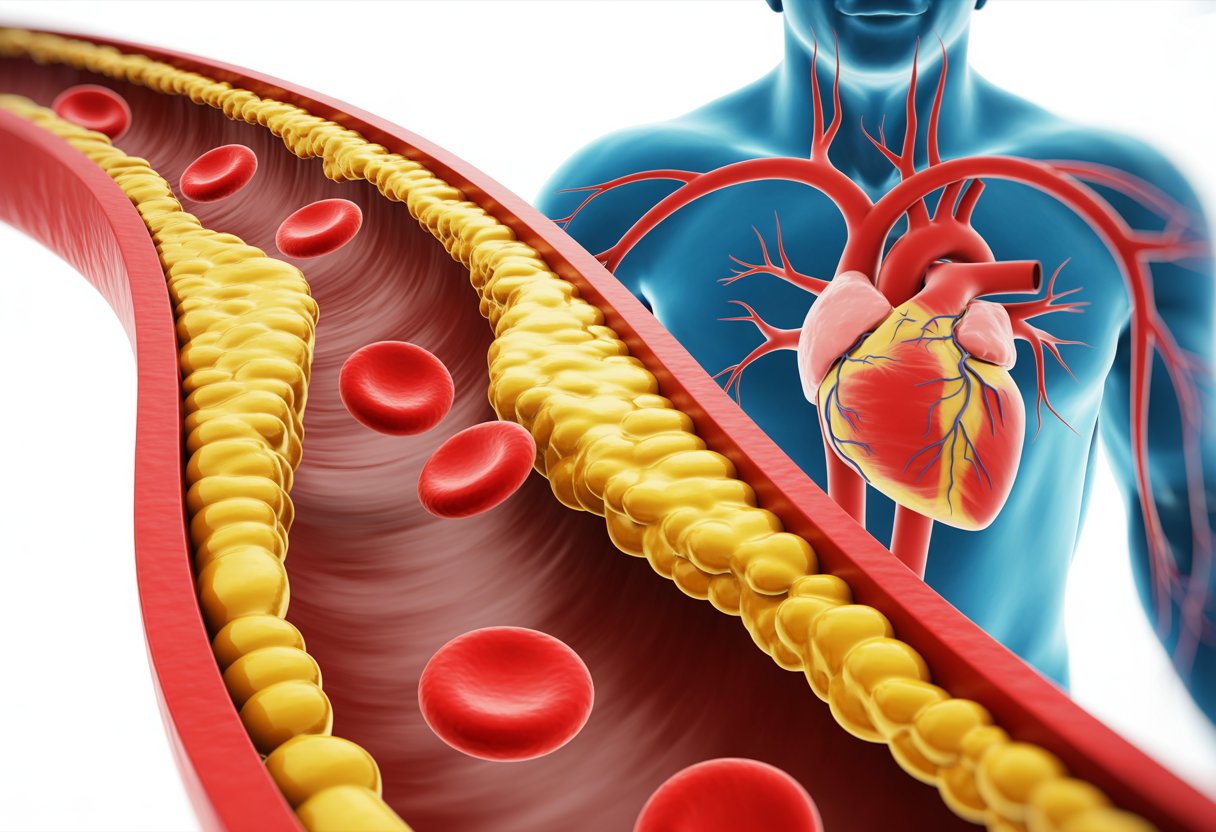
High LDL cholesterol can cause serious heart problems and may not show obvious signs. People often have questions about health risks, symptoms, and ways to lower their cholesterol through diet and lifestyle changes.
What are the potential health risks associated with elevated LDL cholesterol levels?
High LDL cholesterol contributes to plaque buildup[5] in the arteries. This process is called atherosclerosis.
The plaque buildup can lead to coronary artery disease. This affects the heart and reduces blood flow to the heart muscle.
High LDL levels increase the risk of stroke[1]. Plaque can block arteries that supply blood to the brain.
Peripheral artery disease can develop in the arms and legs. This happens when plaque blocks blood flow to these areas.
The largest artery in the body, called the aorta, can develop an aneurysm. This is a dangerous bulging of the artery wall.
Can high LDL cholesterol be asymptomatic, or are there specific symptoms to watch for?
High LDL cholesterol usually has no symptoms. Most people do not feel sick or notice any changes in their body.
The condition is often called a “silent” problem. People can have high cholesterol for years without knowing it[8].
Symptoms only appear when serious problems develop. These might include chest pain from heart disease or leg pain from blocked arteries.
Regular blood tests are the only way to find high LDL cholesterol. Doctors recommend checking cholesterol levels every few years.
What dietary and lifestyle changes are recommended to reduce LDL cholesterol?
Eating heart-healthy foods can lower LDL cholesterol. The Mediterranean Diet is one good option that includes many beneficial foods.
Soluble fiber blocks cholesterol absorption[5] in the body. Fruits, vegetables, and whole grains contain this type of fiber.
People should avoid foods high in saturated fat. These include fatty meats, full-fat dairy products, and fried foods.
Getting 30 minutes of exercise each day helps lower LDL levels. Aerobic activities like walking, swimming, or biking work well.
Maintaining a healthy weight is important. Extra weight can raise LDL cholesterol levels.
Stopping all tobacco use helps improve cholesterol numbers. This includes cigarettes, smokeless tobacco, and vaping products.
Managing stress may help cholesterol levels. Long-term stress can raise LDL and lower good HDL cholesterol.
How does high LDL cholesterol differ from high non-HDL cholesterol in terms of health implications?
LDL cholesterol is one specific type of “bad” cholesterol. Non-HDL cholesterol includes LDL plus other harmful cholesterol types.
Non-HDL cholesterol gives a broader picture of heart disease risk. It includes VLDL cholesterol and other lipoproteins that can cause problems.
Studies show that total cholesterol can be high[9] even when LDL and HDL appear normal. This can still lead to serious health problems.
Doctors often look at both numbers when assessing risk. Non-HDL cholesterol may be a better predictor of heart problems in some people.
What constitutes a high cholesterol level, and at what point should one be concerned?
Most adults should keep LDL cholesterol below 100 mg/dL[5]. This is considered the normal range.
LDL levels between 100-129 mg/dL are near-optimal. These levels may still increase heart disease risk slightly.
Borderline high LDL ranges from 130-159 mg/dL. People in this range should make lifestyle changes.
High LDL cholesterol is 160-189 mg/dL. This level significantly raises the risk of heart problems.
Very high LDL is 190 mg/dL or higher. People with these levels often need medication along with lifestyle changes.
LDL levels above 100 mg/dL raise cardiovascular disease risk[5]. People with heart disease history should aim for LDL below 70 mg/dL.
Are there gender-specific symptoms or risks for high cholesterol in females?
High cholesterol symptoms are the same for males and females. Both groups typically have no symptoms until serious problems develop.
Females typically have higher LDL levels after menopause[5]. Hormone changes during this time affect cholesterol production.
Before menopause, estrogen helps keep cholesterol levels lower. After menopause, this protective effect decreases.
Women may develop heart disease differently than men. They might have different warning signs when cholesterol causes heart problems.
Female heart attack symptoms can be less obvious. These might include fatigue, nausea, or back pain instead of chest pain.
Regular cholesterol testing is important for women of all ages. This becomes especially important after age 50 or menopause.
References
- high LDL often has no symptoms until it becomes serious. https://www.verywellhealth.com/ldl-cholesterol-11783578 Accessed October 28, 2025
- 403 Forbidden. https://www.cedars-sinai.org/blog/why-is-my-cholesterol-high-and-what-can-i-do-about-it.html Accessed October 28, 2025
- LDL Cholesterol | Heart & Vascular Services | University Hospitals | Cleveland, OH. https://www.uhhospitals.org/services/heart-and-vascular-services/conditions-and-treatments/blood-cholesterol/ldl-cholesterol Accessed October 28, 2025
- Cholesterol: Understanding Levels & Numbers. https://my.clevelandclinic.org/health/articles/11920-cholesterol-numbers-what-do-they-mean Accessed October 28, 2025
- LDL Cholesterol: What It Is & How to Manage It. https://my.clevelandclinic.org/health/articles/24391-ldl-cholesterol Accessed October 28, 2025
- Peripheral artery disease develops when plaque clogs arteries. https://www.verywellhealth.com/serious-side-effects-of-high-cholesterol-11767630/ Accessed October 28, 2025
- High blood pressure from damaged blood vessels puts people at higher risk. https://www.heart.org/-/media/Files/Health-Topics/Cholesterol/Consequences-of-high-cholesterol.pdf Accessed October 28, 2025
- Top 11 Questions About High Cholesterol, Answered. https://www.everydayhealth.com/high-cholesterol/living-with/top-questions-about-high-cholesterol-answered/ Accessed October 28, 2025
- What to Do When Your Total Cholesterol Is High but, Your LDL and HDL Levels Are Within the Normal Range. https://www.gilmorehealth.com/what-to-do-when-your-total-cholesterol-is-high-but-your-ldl-and-hdl-levels-are-within-the-normal-range/ Accessed October 28, 2025
